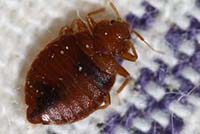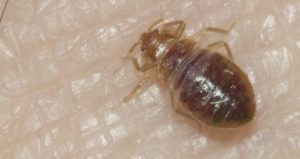Cimex lecturlarius

The vast majority of people have never seen or heard of bed bugs except in the context of some mystical “boogie man.” Parents would commonly say, “Sleep tight, don’t let the bed bugs bite,” as children were put to bed. In fact, bed bugs were also relatively rare for researchers to encounter until the past decade or so. This was largely due in part to the wide spread use and availability of insecticides and improved hygiene.
Once the scourge of every homeowner, bed bugs were thought to have disappeared, particularly with the widespread use of DDT during the 1940s and 1950s. However, there have been nascent populations which have continuously existed throughout the world. Locations in the near and middle east, Africa, Central and South America and Europe have all remained. More recent attention to the presence of bed bugs has been observed in the United States and Australia where they have become highly visible in the hotel and lodging industry. They are increasingly being encountered in homes, apartments, hotels, motels, dormitories, shelters and modes of transport. It is widely believed that international travel and immigration have contributed to the resurgence of bed bugs in this country as well as others. Reliance on integrated pest management (IPM) practices which do not use insecticides and the reduction in the number of different active ingredients are among factors believed to have contributed to this current resurgence trend
Description & Habits
Bed bugs are small, brownish, flattened insects that feed solely on the blood of animals. The common bed bug, Cimex lectularius, is the species most adapted to living with humans. It has done so since ancient times.
Adult bed bugs are about 1/4 inch long and reddish brown, with oval, flattened bodies. They are sometimes mistaken for ticks or cockroaches. The immatures (nymphs) resemble the adults, but are smaller and somewhat lighter in color. Bed bugs do not fly, but can move quickly over floors, walls, ceilings and other surfaces.
Under favorable conditions of temperature (above 70° F) and regular feeding, female bed bugs will lay about 200 eggs during her lifetime at the rate of 3 or 4 per day. Eggs are coated with a sticky substance, causing them to adhere to objects on which they are deposited. The eggs hatch in 6 to 17 days and the nymphs begin to feed on blood immediately. After 5 molts, bed bugs reach maturity. There may be 3 or more generations a year. Environmental factors and the availability of food will cause considerable variation in the developmental rate of all stages of growth. Young and old bed bugs may live for several weeks to several months without feeding, depending upon the temperature.

Bed bugs feed mostly at night, by piercing the skin of people as they sleep. However, if they are very hungry and if the light is dim, they will feed during the day.
When bed bugs bite, they inject a fluid into the skin that assists them in obtaining blood. Often the fluid causes the skin to become irritated , inflamed and to itch. Elongated, spindle shaped welts develop as a result of the bite. If the bites are on the limbs (arms or legs), these welts will be aligned with the long axis of the limb. This elongated, spindle shape distinguishes the welts from those resulting from mosquito or flea bites.
If its feeding is undisturbed, a full grown bed bug becomes engorged with blood in 3 to 15 minutes. It then crawls to its hiding place, where it remains for several days digesting its meal. When hunger returns, the bug emerges from hiding and seeks another meal of blood.
Habitual hiding places are evident by black or brown spots of dried excrement on surfaces on which the bugs rest (shown right). Eggs, egg shells and cast skins also may be seen near these places (shown left). There usually is a distinctive odor in rooms where bed bugs are numerous.
At the beginning of an infestation in a room, bed bugs are likely to be found only about the turfs, seams and folds of mattresses and covers; later they spread to crevices in the bedsteads.
If allowed to multiply, they establish themselves behind baseboards, window and door casings, pictures and picture moldings, and in furniture, loosened wallpaper, cracks in plaster and partitions.
Bed bugs prefer to hide close to where they feed. However if necessary, they will crawl several feet to obtain a blood meal. Initial infestations tend to be around beds, but the bugs eventually may become scattered throughout a room, occupying any crevice or protected location. They also can spread to adjacent rooms or apartments. This can be especially problematic on college campuses and anywhere multi-housing scenarios occur. For this reason, control really must be comprehensive and pest management professionals must think 3-dimensionally.
Bites and Concerns
Because of their cryptic behavior, bed bugs usually bite people at night while they are sleeping. They feed by piercing the skin with their elongated beaks, injecting anti-blood clotting agents (apyrases) and withdraw blood directly from the host. Engorgement varies, but published ranges approximate the time as between 3 and 15 minutes. People seldom know that yhey are being bitten. Symptoms vary for each person, but can range from no reaction to severe welts and swelling. Hypersensitivity studies have demonstrated that in some rare occasions severe bullous bite reactions may occur. The host immune response and potential protein antigens present in the saliva of C. lectularius or specific antibodies have not been characterized thus far. Unlike fleabites, which occur mainly around the ankles, bed bugs feed on any bare skin exposed while sleeping (face, neck, shoulders, arms, hands, etc.). The welts and itching are often attributed to other causes such as mosquitoes. For these reasons, infestations may go a long time unnoticed, and can become quite large before being detected.
A common concern with bed bugs is whether they transmit diseases. Although bed bugs can harbor pathogens in their bodies, transmission to humans is highly unlikely. For this reason, they are not considered a serious disease threat. Their medical significance is mainly limited to the itching and inflammation from their bites. Antihistamines and corticosteroids may be prescribed to reduce allergic reactions, and antiseptic or antibiotic ointments to prevent infection. Infestations also may cause anxiety, embarrassment, and loss of sleep.
Control Methods
To control bed bugs in homes, locate their hiding places such as described above and treat with an insecticide approved for this use. Select a product whose label includes specific directions for bed bug control. Spray or dust beds (slats, springs and frame) and other hiding places about the room.
To control bed bugs in homes, locate their hiding places such as described above and treat with an insecticide approved for this use. Select a product whose label includes specific directions for bed bug control. Spray or dust beds (slats, springs and frame) and other hiding places about the room.
Because it is impossible to penetrate all hiding places, control is usually not immediate. A few living bugs may be seen for a week to 10 days after application. After 10 days, a second application, equal to the first is necessary to kill the just hatching nymphs. The pesticides used for bedbug control have a short residual life and so this second application is always needed. For heavily infested areas, it is recommended that a commercial pest control operator be consulted to control the infestation.
In some instances fumigation may actually be the cheaper alternative (see left). Insecticide label clearances are subject to change and changes may have occurred since this publication was printed. The pesticide USER is always responsible for the effects of pesticides on his own plants or household goods as well as problems caused by drift from his property to other properties or plants. Always read and follow carefully the instructions on the container label.
Origin of Infestations
Bed Bugs are especially efficient at hitchhiking and are a major reason rapid transportation has likely contributed most to the spread of this pest resurgence. They can be transported in/on luggage, clothing, beds, furniture, etc. Occurrences of bed bugs are particularly growing in frequency in countries where tourism is more common. Bed bugs are small, cryptic and agile, escaping detection after crawling into suitcases, boxes, and belongings. The eggs are almost impossible to see when laid on most surfaces. Use of secondhand beds, couches, and furniture is another way that the bugs are transported into previously non-infested dwellings. There is basically no where they can not hide!
Research at Texas A&M
Collaboration between Texas A&M’s Center for Urban & Structural Entomology and the University of Arkansas Insect Genetics laboratory is revealing important clues concerning the reasons for the current resurgence of bed bugs around the world and here in the United States. We are also cooperating with Virginia Tech University on molecular forensic studies which can assist in the identification of hosts for criminal investigations (see molecular diagnostic gel below). Because most registered pesticides currently labeled for bed bug control continue to have control issues, we are also investigating relationships between resistance and specific populations that appear to have elevated levels of insecticide resistance. Molecular investigations of these types will provide valuable information about the scope and nature of bed bug resurgence and offer possible reasons for this emerging pest problem.
One scenario that appears to have merit concerns geographic epicenters where bed bugs radiate from. In our preliminary investigations we have found significant populations occurring in poultry facilities in Arkansas and Texas, and we suspect that resistant populations of bed bugs have slowly increased in numbers in facilities such as these, and have subsequently been transported from poultry workers to other areas where they have subsequently spread. Population genetic studies of both mitochondrial and nuclear DNA reveal no genetic bottlenecks, yet significant variation with no apparent geographic structure with 19 distinct mt DNA halophytes from only 50 populations from throughout the United States (see below). For this reason, we believe that populations never truly died out in the United States, but were forced to alternate their hosts. Ongoing research on host identification from blood meals of bed bugs is currently being investigated to support this hypothesis.
If you have any bed bug questions or would like to contribute samples to this endeavor, please do not hesitate to contact us here at the Center for Urban & Structural Entomology or at the University of Arkansas.